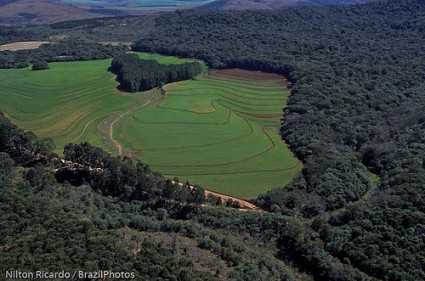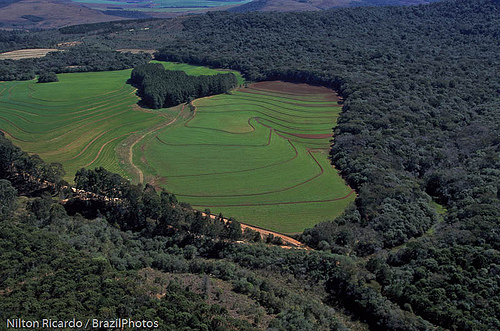 A soy plantation in the Amazon rainforest, Brazil. Nilton Ricardo, BrazilPhotosEveryone should listen to this BBC report (unfortunately not embedabble) on the “price of biofuels.” It digs into a key question: what does Europe’s appetite for biodiesel mean for people and ecosystems in the countries that produce the feedstocks?
A soy plantation in the Amazon rainforest, Brazil. Nilton Ricardo, BrazilPhotosEveryone should listen to this BBC report (unfortunately not embedabble) on the “price of biofuels.” It digs into a key question: what does Europe’s appetite for biodiesel mean for people and ecosystems in the countries that produce the feedstocks?
Focusing on Paraguay, the BBC comes up with answers that aren’t pretty. The economic benefits of the biofuel craze accrue to large plantation owners and the global agribusiness firms that buy their soy and provide the inputs. Tracts of of the Amazon get leveled for soy production. Small-scale tenant farmers get forced off their land and into penury. Inevitably, agrichemicals rain down and seep into streams, wreaking havoc on communities.
In short, we see not the production of a “green” fuel but rather an ecological calamity in service of the idea of green fuel: a highly profitable travesty masquerading as a “solution.”
The focus is the Europe-South America consumption-production chain, but our own corn-ethanol program is implicated. Like crude oil, agricultural commodities like corn and soy are fungible. Archer Daniels Midland and Cargill don’t distinguish between soy grown on Iowa prairie lands and, say, the the Brazilian savanna. In industrial production, soy is soy; and corn is corn. As biofuel production expands, it demands more cropland–affecting farmers’ planting decisions and make therm scramble to increase yields.
Ponder the fact that the U.S. government uses mandates and tax breaks to divert more than a third of the U.S. corn crop into ethanol–and that proportion will rise to more than 50 percent by 2015, if mandates in the Renewable Fuel Standard hold true. As recently as 2004, ethanol burned through just 13 percent of the crop.
All of that corn being diverted into our gas tanks means that somewhere, some industrial agriculturalist sees an opportunity to plow up new land for more corn production. Or switch from soy to corn, putting upward pressure on the price of soy and encouraging more soy in places like the Amazon rain forest or Brazil’s savanna.
Let’s put this into perspective. The U.S. grows 40 percent of the globe’s corn. If one third of it gets transformed into ethanol, that means that more than one out of every eight corn kernels grown in the world now goes into U.S. drivers’ gas tanks. When one half of our corn goes to ethanol, one kernel in five will help power our car fleet.
Let’s think about it another way. The mighty U.S. corn crop sucks up more than 40 percent of the synthetic nitrogen and mined potassium fertilizer used in U.S. agriculture. (Figures extrapolated from this USDA document–and a pox on that agency for presenting this key information in a rather raw Excel document, and not a thought-through HTML.) So again, given that a third of corn goes to ethanol. that means nearly 15 percent of our consumption of this those ecologically devastating, geopolitically troubling resources can be explained by ethanol.
And for what? All to reduce U.S. gasoline consumption by about 6 percent. Reaching that stunningly modest level required decades of steady government support in the form of multi-billion-dollar annual tax breaks, plus research grants and mandates. And to be clear, our ethanol habit barely—-if at all–reduces the total amount of fossil fuel consumed. Production of corn-based ethanol offers a razor-thin net energy gain–and that, only if you grant a generous credit to distillers grains, an ethanol byproduct, as a livestock feed. As I’ve shown before, the mush left over from industrial ethanol production is riddled with antibiotic residues and heart-ruining mycotoxins–not the kind of stuff you’d want to feed to animals you plan to eat (even though the meat indsustry welcomes distillers grains as an “economical” alternative to whole corn).
In short, government-mandated biofuel programs, both in Europe and here, are distractions from the necessary task of reducing fossil energy consumption. They will inevitably cause the destruction of climate-stabilizing ecosystems like rain forests and seperate small-scale farmers from their land. Indeed, both are lready happening.
I can see one hopeful sign from the U.S. biofuel experience, though. It has proved that the U.S. government, even under such alleged free-market zealots as Reagan and Bush II, actually is capable of making sustained public commitments to alternative energy. (Leave aside their loyal and expensive support of the crude-oil industry).
The trick for progressives is to not just attack public support for ethanol, but also to try to shift that spirit of public investment to technologies and projects that actually conserve fossil fuel, like mass transit, dense cities, and efficiency. Meanwhile, Friends of the Earth is circulating an online petition demanding an end to “dirty corn ethanol subsidies.”



